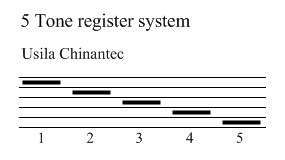Chinantecan languages
| Chinantec | |
|---|---|
| Tsa Jujmi | |
| Native to | Mexico |
| Region | Oaxaca |
| Ethnicity | Chinantecs |
Native speakers | 130,000 (2010 census)[1] |
|
Oto-Mangue
| |
| Language codes | |
| ISO 639-3 |
Variously:cco – Comaltepec Chinantecchj – Ojitlán Chinantecchq – Quiotepec Chinantecchz – Ozumacín Chinanteccle – Lealao Chinanteccnl – Lalana Chinanteccnt – Tepetotutla Chinanteccpa – Palantla Chinanteccsa – Chiltepec Chinanteccso – Sochiapan Chinanteccte – Tepinapa Chinantecctl – Tlacoatzintepec Chinanteccuc – Usila Chinanteccvn – Valle Nacional Chinantec |
| Glottolog |
chin1484[2] |
|
The Chinantecan languages, number 9 (chartreuse), east. | |
The Chinantec or Chinantecan languages constitute a branch of the Oto-Manguean family. Though traditionally considered a single language, Ethnologue lists 14 partially mutually unintelligible varieties of Chinantec.[3] The languages are spoken by the indigenous Chinantec people who live in Oaxaca and Veracruz, Mexico, especially in the districts of Cuicatlán, Ixtlán de Juárez, Tuxtepec and Choapan, and in Staten Island, New York.[4]
Languages
Egland and Bartholomew (1978)[5] established fourteen Chinantec languages on the basis of 80% mutual intelligibility. Ethnologue found that one that had not been adequately compared (Tlaltepusco) was not distinct, but split another (Lalana from Tepinapa). At a looser criterion of 70% intelligibility, Lalana–Tepinapa, Quiotepec–Comaltepec, Palantla–Valle Nacional, and geographically distant Chiltepec–Tlacoatzintepec would be languages, reducing the count to ten. Leolao (Latani) is the most divergent.
| 70% | Language (80% intelligibility) | Where spoken |
|---|---|---|
| * | Chinantec of Lealao | Northeastern Oaxaca, San Juan Lealao, Latani, Tres Arroyos, and La Hondura |
| * | Chinantec of Chiltepec | San José Chiltepec Oaxaca |
| Chinantec of Tlacoatzintepec | Northern Oaxaca | |
| * | Chinantec of Comaltepec | Comaltepec, Northern Oaxaca |
| Chinantec of Quiotepec (Highland Chinantec) |
San Juan Quiotepec and surrounding towns, Oaxaca | |
| * | Chinantec of Lalana | 25 towns on the border between Oaxaca and Veracruz |
| Chinantec of Tepinapa | Northern Oaxaca, Choapan District. Very remote area. | |
| * | Chinantec of Ojitlán | Northern Oaxaca and Veracruz municipos of Minatitlan and Hidalgotitlan |
| * | Chinantec of Ozumacín | San Pedro Ozumacín and surrounding towns, Oaxaca |
| * | Chinantec of Palantla | San Juan Palantla and surrounding towns, Oaxaca |
| Chinantec of Valle Nacional | Yetla, North Oaxaca | |
| * | Chinantec of Sochiapan | Northern Oaxaca |
| * | Chinantec of Tepetotutla | Northern Oaxaca |
| * | Chinantec of Usila | Oaxaca one town in Veracruz |
Segmental phonology
A typical Chinantecan phoneme inventory distinguishes 7 vowels /i, e, a, u, o, ɨ, ø/ and consonants /p f b m θ d t ts s r l n k ŋ ʔ h/. Vowels can be nasalized, except usually /u/ and /ø/.
Tone

Chinantec is a tonal language and some dialects (Usila Chinantec) have five register tones, an uncommon trait in the world's languages. Whistled language is common. In the practical orthographies for Chinantec, tones are marked with superscript numbers after each syllable; in linguistic transcription the dedicated tone diacritics ⟨◌ꜗ ◌ꜘ ◌ꜙ ◌ꜚ⟩ are used.
Chinantec also has ballistic syllables, apparently a kind of phonation.[6][7][8]
Grammar
Grammars are published for Sochiapam Chinantec,[9] and a grammar and a dictionary of Palantla (Tlatepuzco) Chinantec.[10][11]
Example phrase:
- ca¹-dsén¹=jni chi³ chieh³
- ‘I pulled out the hen (from the box).[11]
The parts of this sentence are: ca¹ a prefix which marks the past tense, dsén¹ which is the verb stem meaning "to pull out an animate object", the suffix -jni referring to the first person, the noun classifier chi³ and the noun chieh³ meaning chicken.
Media
Chinantec-language programming is carried by the CDI's radio stations XEOJN, broadcasting from San Lucas Ojitlán, Oaxaca, and XEGLO, broadcasting from Guelatao de Juárez, Oaxaca.
 Example of Chinantec in written form from the Biblioteca Cervantina
Example of Chinantec in written form from the Biblioteca Cervantina.pdf.jpg) Example of Chinantec in written form from the Biblioteca Cervantina
Example of Chinantec in written form from the Biblioteca Cervantina
| Wikimedia Commons has media related to Chinatecan languages. |
References
- ↑ INALI (2012) México: Lenguas indígenas nacionales
- ↑ Hammarström, Harald; Forkel, Robert; Haspelmath, Martin; Bank, Sebastian, eds. (2016). "Chinantecan". Glottolog 2.7. Jena: Max Planck Institute for the Science of Human History.
- ↑ Enrique L. Palancar. Revisiting the complexity of the Chinantecan verb conjugation classes. Forthcoming in Jean-Léo Léonard and Alain Kihm (eds.), Issues in Meso-American morphology. Paris: Michel Houdiard
- ↑ Claudio Torrens (2011-05-28). "Some NY immigrants cite lack of Spanish as barrier". UTSanDiego.com. Retrieved 2015-03-02.
- ↑
- Egland, S. and Bartholomew, D.. 1978. La inteligibilidad inter-dialectal en Mexico: Resultados de algunos sondeos. Mexico, D.F.: Instituto Linguistico de Verano
- ↑ Merrifield, William and Calvin R. Rensch. 1990. Syllables, Tone, and Verb Paradigms, [Studies in Chinantec Languages 4]. Summer Institute of Linguistics and The University of Texas at Arlington.
- ↑ Mugele, R. L. 1982. Tone and Ballistic Syllables in Lalana Chinantec. Ph.D. dissertation. Austin: University of Texas.
- ↑ Rensch, Calvin. 1978. Ballistic and controlled syllables in Otomanguean Languages, in Alan Bell and Joan B. Hooper (eds.), Syllables and Segments, pp. 85-92. Amsterdam : North Holland Publishing Company.
- ↑ Foris, David Paul. 2000. A grammar of Sochiapam Chinantec. Studies in Chinantec languages 6. Dallas, TX: SIL International and The University of Texas at Arlington.
- ↑ Merrifield, William R. 1968. Palantla Chinantec grammar. Papeles de la Chinantla 5, Serie Científica 9.México: Museo Nacional de Antropología.
- 1 2 Merrifield, William R. and Alfred E. Anderson. 2007. Diccionario Chinanteco de la diáspora del pueblo antiguo de San Pedro Tlatepuzco, Oaxaca. [2nd Edition]. Serie de vocabularios y diccionarios indígenas “Mariano Silva y Aceves” 39. Mexico DF: Summer Linguistic Institute..
External links
- The Chinantec language family (SIL-Mexico)
